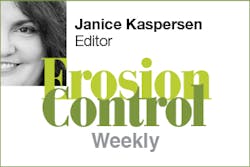
This month southern California has been in the news for—what else?—mudslides that closed freeways, buried cars, and rerouted traffic throughout the state, but amazingly did not result in any human deaths. With El Niño conditions predicted for the coming months, the state will likely see more frequent and heavier rains—and more mudslides.
Another thing we’re known for here in California is wildfires. Forester’s group editor, John Trotti, recently pointed out this article, explaining that with the drought fires are also becoming more frequent and more intense. The traditional May-to-October fire season is getting longer, and the lack of moisture is allowing some fires to burn faster and hotter than usual.
- BMP Case Studies
- Green Infrastructure
- Stormwater Program Management
- Advanced Research Topics
- Water-Quality Monitoring
- Industrial Stormwater Management
- Stormwater Management for Solid Waste Facilities
That’s a lousy combination. The traditional one-two punch—fires remove the vegetation from the hillsides, and storms wash those hillsides away—will hit harder, at least in parts of the Western US.
This article from the November/December 2015 issue of Erosion Control takes a closer look at the post-fire risks of erosion and landslides, the history of how we’ve managed fires in the US, and which parts of the country should be most concerned.
The article also includes a summary of recent studies on the use of hydromulch. Researchers wanted to know whether the use of hydromulch and tackifier to prevent erosion following a fire might actually interfere with the regeneration of native vegetation—which would be an ironic situation at best. Both studies showed that application of hydromulch did not affect long-term recovery; see the sidebar at the end of the article for details and methods of the studies.
Are any special preparations being made in your area for increased fire activity, altered storm patterns, or both?
StormCon Call for Papers Is Open
StormCon, the only North American event dedicated exclusively to stormwater and surface-water professionals, is seeking abstracts for presentation at StormCon 2016. The deadline for submitting abstracts is Wednesday, December 9.
The conference will be held in Indianapolis, IN, August 22–25, 2016. We are looking for abstracts in the following conference tracks:
- BMP Case Studies
- Green Infrastructure
- Stormwater Program Management
- Advanced Research Topics
- Water-Quality Monitoring
- Industrial Stormwater Management
- Stormwater Management for Solid Waste Facilities
For more information, including the complete call for papers and an online form for submitting your abstract, visit www.StormCon.com.
About the Author
Janice Kaspersen
Janice Kaspersen is the former editor of Erosion Control and Stormwater magazines.



